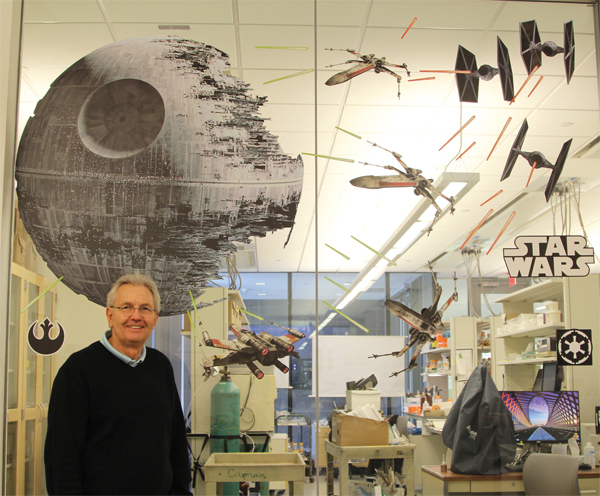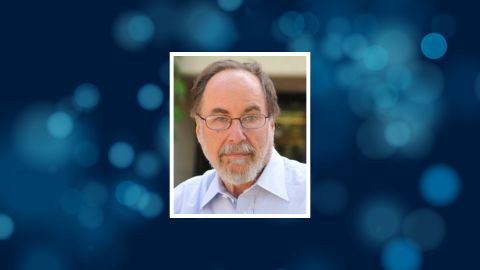Membrane maestro George Carman returns to the JLR
What a cell does with its lipids is a subject of deep inquiry. George Carman’s laboratory at Rutgers University examines the genetic and biochemical control mechanisms that cells use to balance the synthesis of triacylglycerol, or fat, for stasis and synthesis of membrane phospholipids for growth.
Carman received his Ph.D. from the University of Massachusetts in Amherst after attending Seaton Hall University and William Patterson University in New Jersey. He did his postdoctoral research with the biochemist William Dowhan at the University of Texas medical school in Houston and is the founding director of the Rutgers Center for Lipid Research.
A seasoned editor and reviewer, Carman has been involved in various capacities with the Journal of Biological Chemistry, as well as Biochimica et Biophysica Acta-Lipids, Applied Environmental Microbiology, Analytical Biochemistry and the Journal of Bacteriology, since the mid ’90s. He previously served as an associate editor of the Journal of Lipid Research from 2003 to 2006.
Carman re-joined the ranks of associate editors at the JLR in January 2017. He spoke with John Arnst, ASBMB Today’s science writer, about his lab’s work and his longtime interest in lipids and cell membranes. The interview has been edited for clarity and length.
What is your group focused on?
Our experimental system is baker’s yeast, and our current focus is on the phosphorylation and dephosphorylation of the phosphatidic acid phosphatase enzyme, whose activity plays a key role in partitioning phosphatidic acid between the synthesis of fat and phospholipids. We identified the gene for this enzyme, which allowed us to make mutations in the gene; and then, by looking at phenotypes of the mutants, we could understand how the enzyme was involved in lipid metabolism. The enzyme plays a key role at a branch point in lipid metabolism, controlling whether cells make membrane phospholipids for growth or take the phosphatidic acid and make triglyceride.
 One of the walls in George Carman’s lab reflects his appreciation of Star Wars. IMAGE COURTESY OF GEORGE CARMAN
One of the walls in George Carman’s lab reflects his appreciation of Star Wars. IMAGE COURTESY OF GEORGE CARMAN
This is something that we’ve worked on for a number of years, and when we discovered the gene for this enzyme in 2006, there was a whole explosion in studying how this enzyme works. It’s so important in governing whether cells make fat or membrane phospholipids that we’re trying to understand how it ticks.
How did you become involved in working with membranes?
After graduation I looked for postdoctoral positions, and one of the places that I applied to was the University of Texas medical school in Houston with William Dowhan.
In 1972, Singer and Nicholson came out with their famous model of what the membrane looks like that has membrane phospholipids and proteins and the proteins moving through it. (Author’s note: Seymour J. Singer and Garth L. Nicholson’s fluid mosaic model is regarded as a cornerstone of cell biology.) After that publication, everybody in the world was working on membrane structure and function; that was Dowhan’s interest, and that’s one of the reasons why I wanted to go to work with Dowhan. That’s why I became very interested in the biosynthesis of membrane phospholipids, because these enzymes that make the phospholipid membranes, they’re also part of the membrane themselves, so they’re kind of synthesizing the environment that they live in.
Did anything occur in a milestone sort of way that made you choose science as a career?
I grew up in Jersey City, where the teachers were more concerned with making sure somebody didn’t get killed or get into drugs ... it was a horrible way that I grew up, and I always did well in chemistry and biology, so I gravitated to that. I had biology teachers and chemistry teachers in high school that really encouraged me to work hard, and I think those are the things that kept me going. My mother is the only one in the family who finished high school before my older sister, and I was the first one in my family to go to college.
I wanted to be a high school teacher like the biology teacher and the chemistry teacher that encouraged me. Then when I went to college I met other chemistry and biology professors that encouraged me, and I wanted to be like them, so instead of being a high school teacher, my goal was to become a college professor. I didn’t know anything about research.
When I wound up going for my master’s degree, I had a research project working with enzymes and bacteria, and I said, “This is fun.” Then I went to the University of Massachusetts, and I met this microbiologist who was studying enzymes, and I really liked it. Doing the independent research is very different from doing research in a laboratory course, and this was where I began to really think that this is my calling.
I’m still a teacher, and I spend a lot of time with my students — my research students but also my classroom students — and I try to do for them what my teachers did for me, so part of my motto is pay it forward. Sometimes you can’t pay back your teachers that helped you, but you pay it forward by helping people that are coming up … I often call Dowhan up and ask him for advice. I’m 67 years old and he’s 75, and the learning doesn’t end. The training begins early, but it keeps going.
What does it mean to you, on a personal level, to be an associate editor at the JLR?
One thing that I’d like to do is help facilitate the growth of the journal. If you have a paper that’s focused and it doesn’t really belong in (a broad journal like) JBC, the JLR is the place that you want to go. What I want to do is get out there and convince all of the people in the field that the JLR is the best place for that specialized lipid paper.
What do you do outside of the lab? Do you have any hobbies?
I play racquetball or I go swimming every day. Exercise is really important in my life to keep healthy. I also play tennis in the warmer weather, and in the cold weather we have family ski trips.
One thing that’s really critical in balancing your life is your family, and it’s really important that family comes first. I have three children, and one grandchild as of July. My oldest daughter works for a flavor company as a marketing analyst, so she really didn’t go into science, and my older son is a pilot in the Coast Guard. My third child just started graduate school at the University of Pennsylvania in biochemistry.
All we wanted them to do is be good citizens and that kind of thing. We spent a lot of time with our kids, and it’s paid off, because they haven’t gotten in trouble and they’re just really good kids.
Do you have any words of wisdom or a favorite motto?
One thing that I teach my students is to always give other people credit for what they do. If you give other people credit, it doesn’t detract from you. There’s a lot of politics in science, and if you always promote the work of others, you’re not going to make enemies. My motto is be fair to the people who made the discoveries; don’t forget the past.
The other thing that I say is just because something’s published doesn’t mean it’s true; it doesn’t mean it’s fact. There’s a lot of stuff out there that’s fabricated; a lot of stuff out there — it’s just not true. So I always impress upon my students to question what’s published, and if you have to do the experiment over to make sure it’s correct, do it over, because you want to get the science right.
Enjoy reading ASBMB Today?
Become a member to receive the print edition four times a year and the digital edition monthly.
Learn moreGet the latest from ASBMB Today
Enter your email address, and we’ll send you a weekly email with recent articles, interviews and more.
Latest in People
People highlights or most popular articles

Bioart for fall: From order to disorder
The cover of the fall issue of ASBMB Today was created by ASBMB member, Soutick Saha, a bioinformatics developer at Wolfram Alpha LLC.

Doudna wins Priestley Medal
She will receive a $20,000 research grant and will formally accept the honor at the ACS Spring 2026 conference.

In memoriam: David Baltimore
He was a Nobel laureate, president emeritus at the California Institute of Technology and an ASBMB member for more than 50 years.

In memoriam: Stuart A. Kornfeld
He was a pioneer in glycobiology and was a member of the American Society for Biochemistry and Molecular Biology for more than 50 years.

Top reviewers at ASBMB journals
Editors recognize the heavy-lifters and rising stars during Peer Review Week.

Cedeño–Rosario and Kaweesa win research award
The award honors outstanding early-career scientists studying cancer, infectious disease and basic science.

